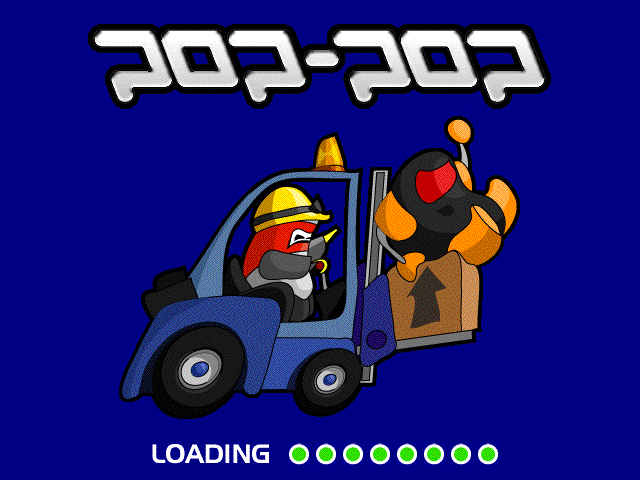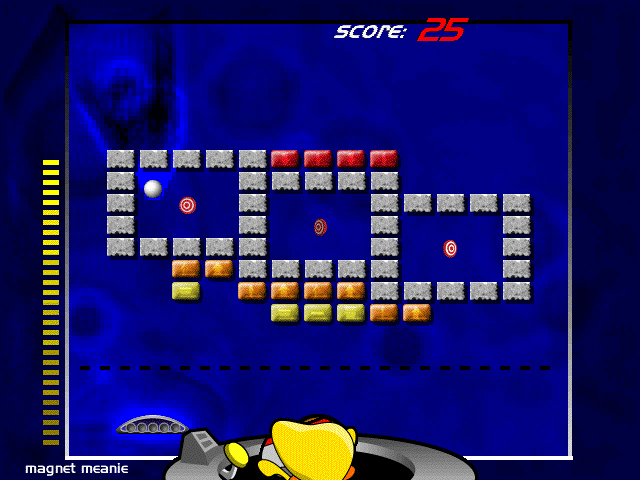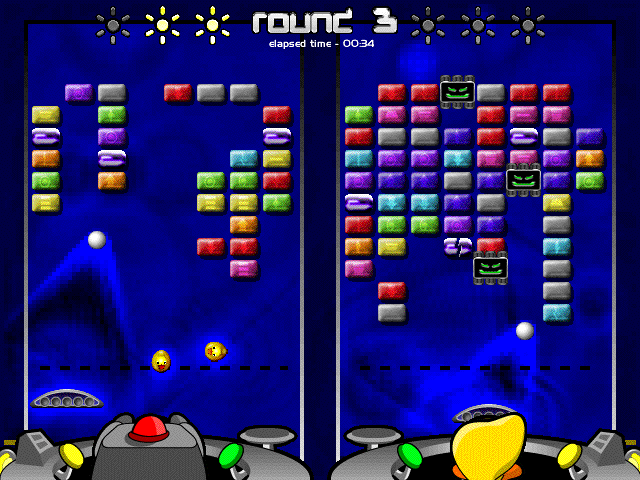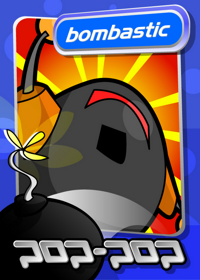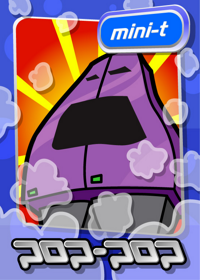pop-pop – Ambrosia Software - 2002 - First time playing?: Yes!
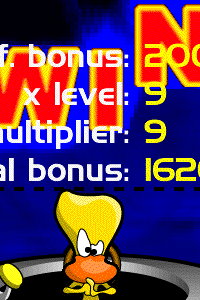 Last time we visited Ambrosia Software's superb library of Mac shareware, we looked at the cult classic Escape Velocity, where this doll became a ruthless all-conquering space pirate forcing the galaxy into submission under his heel.
Last time we visited Ambrosia Software's superb library of Mac shareware, we looked at the cult classic Escape Velocity, where this doll became a ruthless all-conquering space pirate forcing the galaxy into submission under his heel.
This time, I became a duck. I do normal duck things like conjure an infinite supply of rubber ducks and play Breakout.
Ambrosia's library is vast and covers nearly every genre under the sun, and while many of them may be unadventurous arcade game clones propped up primarily by an offbeat sense of humour, games like Escape Velocity and Harry the Handsome Executive show just how unique and creative they can be when they make something original by contrast, and pop-pop is another example of this. A chaotic mixture of Breakout, air hockey, Puzzle Bobble and Magical Drop all into one, pop-pop almost defies genre but could be loosely grouped into being a "puzzle" game. Even that doesn't quite feel right, it's a very arcade action kinda game encouraging speed and precision, with light puzzle elements in its single-player level design and versus mode competitive elements.
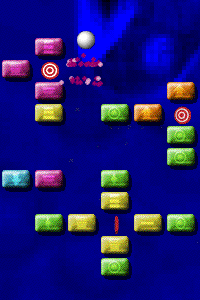 You've got two modes to choose from here, versus and puzzle. I'd argue that versus is the main draw here, but puzzle is also the more gentle introduction to pop-pop's unique control scheme and mechanics, so we'll start here. In our introduction to our duck escapades, you play as the duck. The duck has control over the paddle at the bottom of the screen and there is a ball for you to bat with the paddle to hit the bricks and targets above you, which the ball will break and bounce off of once it makes contact with. Your objective in every level is to break all of the targets in order to clear the stage. If you’ve played Breakout, Arkanoid or any variant or descendant of those games then this will all look very familiar, but there’s a few quirks here that make pop-pop stand out.
You've got two modes to choose from here, versus and puzzle. I'd argue that versus is the main draw here, but puzzle is also the more gentle introduction to pop-pop's unique control scheme and mechanics, so we'll start here. In our introduction to our duck escapades, you play as the duck. The duck has control over the paddle at the bottom of the screen and there is a ball for you to bat with the paddle to hit the bricks and targets above you, which the ball will break and bounce off of once it makes contact with. Your objective in every level is to break all of the targets in order to clear the stage. If you’ve played Breakout, Arkanoid or any variant or descendant of those games then this will all look very familiar, but there’s a few quirks here that make pop-pop stand out.
First off, missing the ball isn’t a life lost like in other Breakout games. If you miss the ball it will simply bounce back up off the bottom of the screen, however all of the bricks descend by one row each time you miss. The bricks also gradually lower on their own the longer you play a single level for, with the objective being to clear out all of the targets before any brick or target crosses the “line of destiny”, the fancy given name for the dotted line above the paddle. Much like Puzzle Bobble, the second that line is crossed, that’s when the game is over.
The more significant twist on the Breakout formula however is the paddle itself and your control over it. Not only can you move the paddle left or right, but also up and down, freely in any direction to any spot below the line of destiny. The paddle is controlled by the mouse and the control is buttery smooth and as precise as you need for a game like this, but also this greatly changes the level of control you have over the ball itself. Much like a real life air hockey puck, slamming the paddle into the ball by giving it a hard upwards shove will send the ball flying at a higher speed. If you want to slow the ball down meanwhile you can pull the paddle backwards as you catch it to do so. The control was literally praised just earlier in this same paragraph but I’ll do it again, this genuinely makes the mouse feel like an actual air hockey paddle and makes the control over the in-game paddle and how you can use it to affect the trajectory and speed of the ball immediately understandable and will come naturally to anyone who’s ever played at an arcade. Being able to smack the ball hard to quickly break targets while time is of the essence and you can’t afford to play slowly, but also catching the ball to slow it down to aim a more precise shot, it feels fantastic and I’m honestly shocked that I haven’t played any other Breakout games with a control scheme similar to this, it’s a perfect fit for this style of gameplay.
 Not only that, but you also have two special abilities mapped to your primary mouse button. First off is the charge, fuelled by the energy gauge represented by those yellow bars to the left of the play field. Every time your paddle hits the ball, that gauge goes up by one bar. You can then click the mouse button to charge your paddle, indicated by those grey circles on the paddle turning yellow. When a charged paddle bats the ball, that ball is now charged and will break through bricks without bouncing off of them allowing you to clear out more bricks and targets even faster. How many bricks the ball will break through before it starts bouncing off them again is dependent on how much you charge the paddle, and you can further increase how much you can charge the paddle by getting the power-up that expands your paddle’s length.
Not only that, but you also have two special abilities mapped to your primary mouse button. First off is the charge, fuelled by the energy gauge represented by those yellow bars to the left of the play field. Every time your paddle hits the ball, that gauge goes up by one bar. You can then click the mouse button to charge your paddle, indicated by those grey circles on the paddle turning yellow. When a charged paddle bats the ball, that ball is now charged and will break through bricks without bouncing off of them allowing you to clear out more bricks and targets even faster. How many bricks the ball will break through before it starts bouncing off them again is dependent on how much you charge the paddle, and you can further increase how much you can charge the paddle by getting the power-up that expands your paddle’s length.
If you hold the mouse button instead of tapping it however, you’ll instead pull out the magnet. While holding the magnet the ball will magnetise directly towards the paddle, also passing through (but not breaking) any bricks along the way. Not only does this help with catching the ball but it can also be used sparingly to gently manipulate and curve the trajectory of the ball while it’s up at the top of the screen, far out of the reach of the paddle. The downside however is that your score ticks down for the duration you’re holding the button for, so while it can be worth it in a lot of regards, relying on it heavily can kill your score badly. Either way, this adds yet again even more control over the ball and even more strategy to consider in moment to moment gameplay.
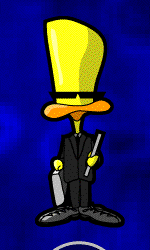 Puzzle mode is divided up into four difficulty levels, easy, normal, hard and expert. Honestly, easy mode is just dull thanks to it slowing down the max speed of the ball significantly, while normal mode is also extremely easy even for this doll as a first-time player. Each difficulty level is a different set of levels that are randomly ordered and then loop once you’ve cleared them all, and on my first try I had no trouble causing normal mode to loop through all of its levels nearly twice. For as amazing as the controls are, it feels like the designers were maybe struggling a bit to balance levels to be suitably challenging for that control scheme, resulting in you feeling somewhat overpowered. Hard mode is probably what I would have called normal, it’s still not too challenging but you’re more likely to run into close calls here than you would in normal. Expert meanwhile more than lives up to the title, its levels requiring smart and precise use of all of your abilities and being incredibly fast to boot, with unbreakable stone blocks always close to the line of destiny. There’s even some levels that require you to use the magnet to hit otherwise inaccessible targets locked behind stone blocks. It’s a neat way to teach some of the mechanics that maybe aren’t immediately apparent when playing for the first time that will come very much in handy in the versus mode.
Puzzle mode is divided up into four difficulty levels, easy, normal, hard and expert. Honestly, easy mode is just dull thanks to it slowing down the max speed of the ball significantly, while normal mode is also extremely easy even for this doll as a first-time player. Each difficulty level is a different set of levels that are randomly ordered and then loop once you’ve cleared them all, and on my first try I had no trouble causing normal mode to loop through all of its levels nearly twice. For as amazing as the controls are, it feels like the designers were maybe struggling a bit to balance levels to be suitably challenging for that control scheme, resulting in you feeling somewhat overpowered. Hard mode is probably what I would have called normal, it’s still not too challenging but you’re more likely to run into close calls here than you would in normal. Expert meanwhile more than lives up to the title, its levels requiring smart and precise use of all of your abilities and being incredibly fast to boot, with unbreakable stone blocks always close to the line of destiny. There’s even some levels that require you to use the magnet to hit otherwise inaccessible targets locked behind stone blocks. It’s a neat way to teach some of the mechanics that maybe aren’t immediately apparent when playing for the first time that will come very much in handy in the versus mode.
Versus mode is where all of the mechanics really come together and feel like they’re implemented to their fullest. Here you can play as our good friend the duck or one of the six other playable characters in a tournament, or play against a friend locally. You also used to be able to play online, but sadly that feature is no longer functional, and somehow I doubt that the servers would be populated in 2023 even if it was still online, thanks to how obscure the game is. Regardless, versus mode will look familiar to any fans of Puzzle Bobble or Magical Drop, incorporating elements from both games into its rules. It’s a classic arcade-style split screen versus puzzle game where the player that lasts the longest wins. Much like Puzzle Bobble, the more bricks you break in a single shot without using the magnet result in more bricks being sent over to your opponent’s play field. For a short duration of time, those bricks you sent over will have a blinking black square inside of them, and if those bricks are broken by your opponent during that period, those broken bricks will immediately be sent back to you, allowing for a slight bit of countering. Where things really get interesting however is where this game reminds me of Magical Drop, that being in how every character has their own unique special power to shake up the game with.
 In order to use a special power you must hold down the secondary mouse button while the ball is airborne in order to charge it up, indicated by an icon representing your power gradually getting colorised to the right of your cockpit. Charging a special power costs four energy and if your paddle hits the ball before the special power is fully charged you will then lose both the energy and the power, so you need to be careful. If you do charge it up in time however, next time your paddle hits the ball the power will activate, introducing some kind of hindering obstacle to your opponent’s screen.
In order to use a special power you must hold down the secondary mouse button while the ball is airborne in order to charge it up, indicated by an icon representing your power gradually getting colorised to the right of your cockpit. Charging a special power costs four energy and if your paddle hits the ball before the special power is fully charged you will then lose both the energy and the power, so you need to be careful. If you do charge it up in time however, next time your paddle hits the ball the power will activate, introducing some kind of hindering obstacle to your opponent’s screen.
Bombastic’s power has him rain bombs upon his opponent’s screen which must be catched with the paddle or else their bricks are lowered. Ducky spawns a rubber duck on his opponent’s play field, functioning as a bumper that never despawns. Ioni covers her opponent’s screen in vision-obscuring spinning flowers. Mini-T blows a big gust of wind at his opponent’s paddle which can potentially push you away from the ball. Mr Man spawns a little robot that places bricks down in a vertical column, getting closer to the line of destiny the longer you leave them on screen. Tex summons two revolvers that spin and fire bullets that stun his opponent’s paddle if they hit it. Finally, Zap summons sparks that repel his opponent’s ball, causing it to veer off course.
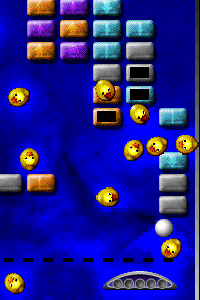 I won’t lie, some of these feel unbalanced. Poor Zap’s sparks seem to actually help me more than they hinder me by keeping the ball up longer and racking up a greater combo, and Ioni’s flowers don’t really impact much since they’re not physical hazards and the ball moves predictably enough that less vision isn’t too major of an issue. By contrast, Ducky’s rubber ducks may seem like a joke at first but since they stay on screen forever and never despawn and you can summon an infinite amount as long as you have the energy, the longer a fight with Ducky goes the more his opponent is put at a brutal disadvantage. Mr Man’s bricklaying robots also get very close to the line of destiny very quickly if you don’t dispatch them instantly, which becomes difficult if he starts spawning them in rapid succession.
I won’t lie, some of these feel unbalanced. Poor Zap’s sparks seem to actually help me more than they hinder me by keeping the ball up longer and racking up a greater combo, and Ioni’s flowers don’t really impact much since they’re not physical hazards and the ball moves predictably enough that less vision isn’t too major of an issue. By contrast, Ducky’s rubber ducks may seem like a joke at first but since they stay on screen forever and never despawn and you can summon an infinite amount as long as you have the energy, the longer a fight with Ducky goes the more his opponent is put at a brutal disadvantage. Mr Man’s bricklaying robots also get very close to the line of destiny very quickly if you don’t dispatch them instantly, which becomes difficult if he starts spawning them in rapid succession.
On the other hand, this also leads to what I consider the best aspect of pop-pop, that being the balancing of basically everything else. This is where the vertical movement you have over the paddle and how you can use it to influence the speed of the ball really comes into play, with players switching between offence and defence as the battle necessitates. Playing aggressively can often mean leaving yourself open and ignoring the descending bricks, you’re likely going to want to have the ball moving slowly so you have time to charge up the special power before you need to bat it again, but that also means you’re clearing out bricks slower too. Getting a great combo where you break a ton of bricks in a single volley by smacking the ball up to the top of the screen above all the bricks will hit your opponent hard once the ball comes back down, but it might take a long time before it finally bounces its way back down to the paddle and thus you are again left open. You can use the magnet to get it back quicker if you urgently need to play defensively, but that also means sacrificing your combo and thus not sending any bricks to your opponent. On the other hand, when playing defensively by breaking blocks close to the line of destiny in rapid succession, your energy gauge gets filled up extremely fast which gives you a lot of ammo to counter back the second you’ve cleared up all of the immediate danger and can go back on the offence.
 The character you’re playing as and the character you’re playing against can also make a huge difference to your strategy too. When playing as Ducky I want to get as many specials in as quickly as I can to spawn in as many hindering ducks early to give myself an advantage later on. With someone like Mini-T however I’d rather focus on getting combos to send bricks over to my opponent, then catching the ball at the end of that combo with a charged super to impact their ability to counter those bricks. When up against Mr Man you’re likely going to be playing more defensively since you keep to keep an eye on the bricklaying bots, whereas when up against Ducky you want to play aggressively to do as much damage as you can before he has a chance to spawn in too many ducks. Even with such simplistic mechanics, pop-pop manages to demonstrate a wide amount of variables that add a level of strategy and seesawing stakes between the two players. I can imagine this being an absolute blast in local multiplayer against human-shaped friends. I’m sure living dolls are just as suitable as opponents as humans.
The character you’re playing as and the character you’re playing against can also make a huge difference to your strategy too. When playing as Ducky I want to get as many specials in as quickly as I can to spawn in as many hindering ducks early to give myself an advantage later on. With someone like Mini-T however I’d rather focus on getting combos to send bricks over to my opponent, then catching the ball at the end of that combo with a charged super to impact their ability to counter those bricks. When up against Mr Man you’re likely going to be playing more defensively since you keep to keep an eye on the bricklaying bots, whereas when up against Ducky you want to play aggressively to do as much damage as you can before he has a chance to spawn in too many ducks. Even with such simplistic mechanics, pop-pop manages to demonstrate a wide amount of variables that add a level of strategy and seesawing stakes between the two players. I can imagine this being an absolute blast in local multiplayer against human-shaped friends. I’m sure living dolls are just as suitable as opponents as humans.
Something I’m torn on with pop-pop is the presentation. It’s charmingly early 2000s and there’s a really nice water effect in the background of the play field, showing water rippling as the ball makes waves while gliding across the screen which can be pretty mesmerising. It’s mainly the character designs where I’m less enthused, they really don’t do much for me personally. The entire cast basically look like lumpy bean bags with angry faces drawn on them, with the exception of Ducky and Ioni, but Ioni looks like an ugly wojak reaction image from Twitter so I’m not giving her props for her design either. Some of them really lack visual personality too, like Mr Man for instance. His bio says that he’s a mob boss which sounds like it has potential for a fun design, maybe giving him a cigar that looks like a fuse to go with the robot aesthetic, or even just give him a suit or something like that, but nothing about his design really reflects his mafia background at all. Same with Zap who is apparently a martial artist despite looking like a potato wrapped in tinfoil. It’s clear that pop-pop is going for a minimalist and stylised kind of appeal, similar to many thick outlined cartoons around the era, but the designs just aren’t quite interesting enough to make it work in my opinion. Your mileage may vary on that one depending on if the style clicks with you or not.
On the other hand, the soundtrack is utterly incredible. Like, seriously, do yourself a favour and give it a listen, it’s phenomenal, easily my favourite soundtrack from all the games I’ve reviewed so far. This style of electronic trance mixed with watery popping and bubbling sound effects pairs perfectly with the previously mentioned background water effects to create an almost psychedelic vibe, while still being upbeat enough to fit the hectic action puzzle gameplay. I might be a bit biassed as I love trance music in general and it’s a woefully underutilised genre in most video games, but nonetheless pop-pop is a pop-bop.
There’s a lot that won me over with pop-pop, I had a blast with it. Unfortunately, my earlier nitpicks aside, my biggest issue with it is that it’s just a bit lacking in content. This is definitely a game that hinges on multiplayer giving it longevity, which is a shame given that you can’t play online anymore. As it stands, you have the puzzle stages which can be easily cleared in a single sitting (except the expert level set) and the versus CPU tournament which is only seven matches long. That’s all you’ve got for single-player content and I feel the well dries up far too quickly. Still, I absolutely recommend giving pop-pop a look if you have the means to, especially if you have friends who would be up for a new versus puzzle game after years of Panel de Pon and Super Puzzle Fighter. It might not have the lasting appeal of the greats of the genre, but it’s got enough unique ideas well executed to stand out among them.
- Page written by MSX_POCKY, 21st July 2023
